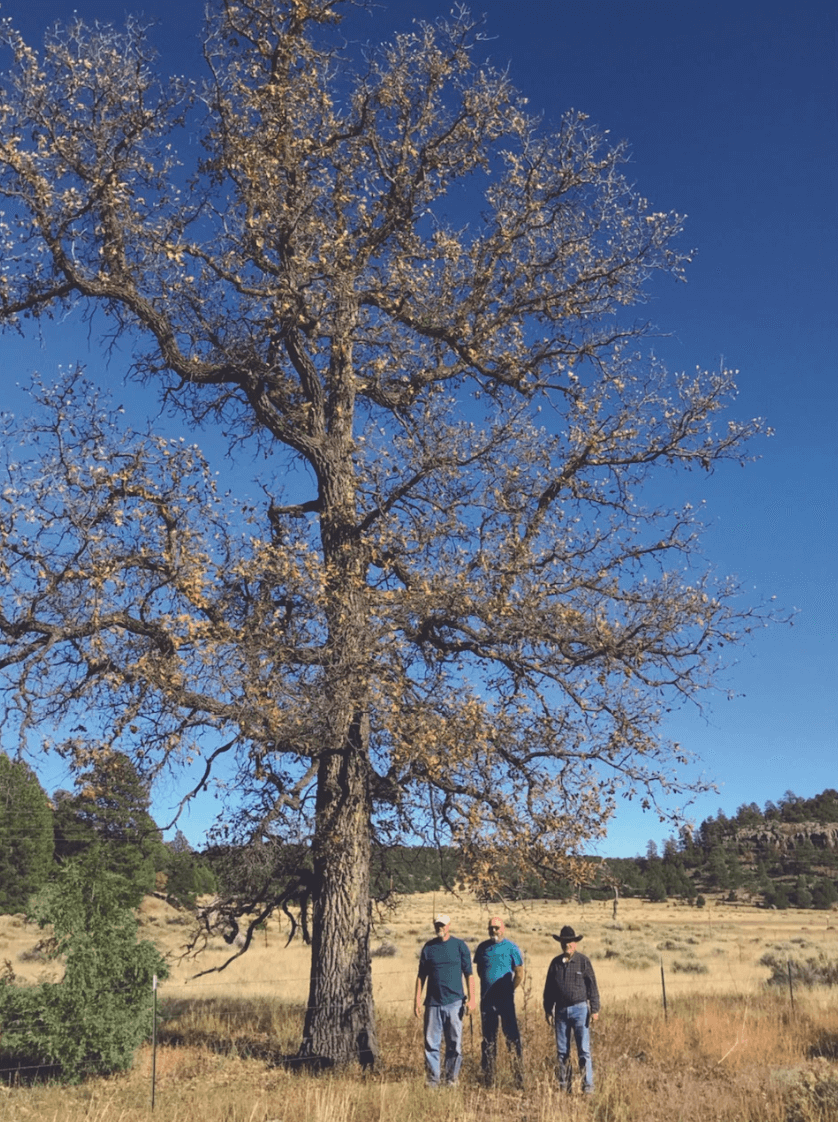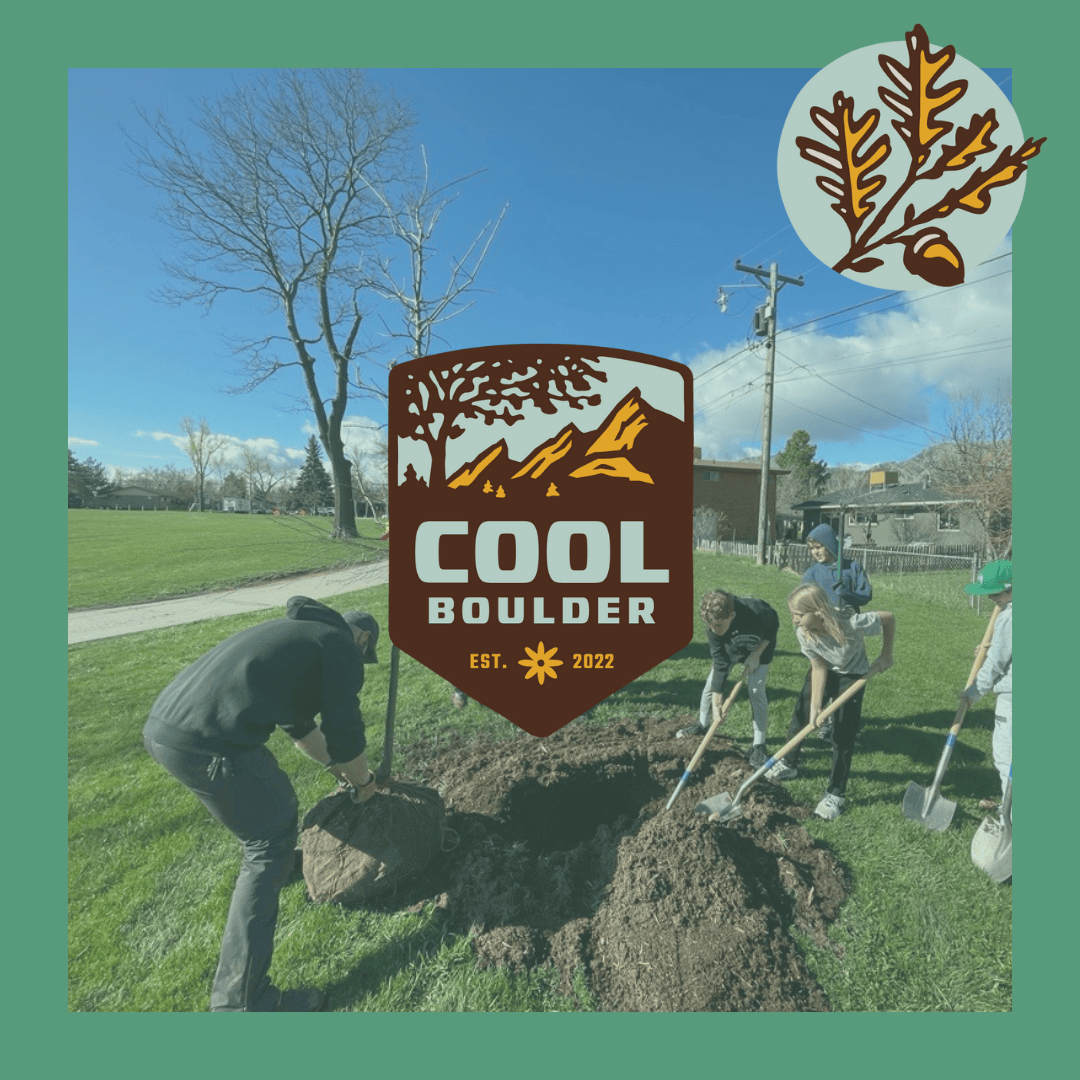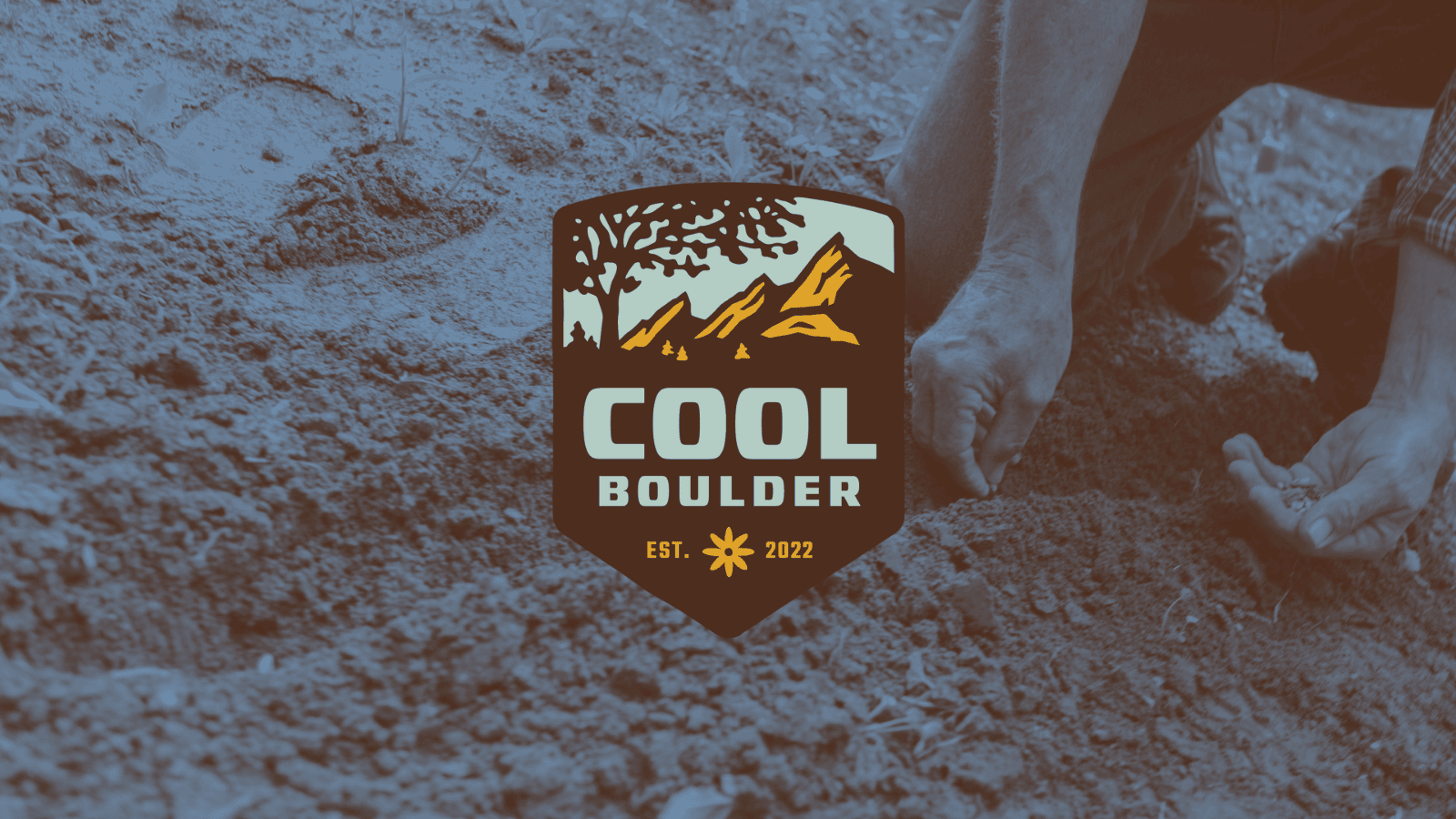Trees for a Changing Climate & Resilient Urban Forest
This article first appeared in the Spring 2022 issue of The Colorado Gardener, one of our community’s greatest resources for anyone growing plants! Reprinted with permission.
If you look at old photos of Colorado Front Range cities, you won’t see many trees. And if you look up native trees of Colorado, you will find a lot of mountain-growing conifers and just a few deciduous trees that grow along streams. Yet our quality of life depends on trees. They provide shade and cooler conditions; they attract and support birds, bees and other life; they create microclimates that make it easier to grow smaller plants, flowers and fruit; and they create beauty. So early settlers planted trees and created systems to bring water from the mountains to drink, bathe with, and to support plants.
‘Gila Monster’, a Gambel Oak selection from western NM that doesn’t sucker, has a single trunk, is cold tolerant to -30F and very drought tolerant. Photo credit: Scott Skogerboe.
This plant culture was not easily gained, in particular with our difficult-for-trees western conditions. At the Eighth Annual Tree Diversity Conference on March 4th, our Front Range conditions for growing trees was described as “harsh”. We have hot summers, cold winters, low rainfall, low humidity, alkaline arid-style soils, late spring and early fall freezes, strong winds, and a month shorter growing season than the Midwest and East. It is much easier to grow a tree in Iowa or Pennsylvania.
Conditions are predicted to be getting worse. At the Tree Conference, speakers were confident in models showing temperatures increasing more rapidly than in the past and even faster for higher elevations because heat rises. On top of that, large numbers of ash trees, cottonwoods, and weak trees will be disappearing, increasing the “heat island effect”. Asphalt, metal and concrete in roads, parking lots, and buildings absorb and retain the sun’s heat where no trees provide shade. Trees also reduce the compacting effect of rain and absorb storm water. Higher density building means less room for tree roots. These stressful conditions weaken trees making them more vulnerable to pests and diseases.
Trees are particularly vulnerable to climate change and very important both in preventing it and maintaining livable conditions. What can we do to improve our urban forest and prepare it for climate change? One obvious solution is to increase tree diversity; with more varieties it’s less likely that large numbers of trees could die because of a pest, disease, drought or other problem. But where conditions are difficult, people naturally want to grow trees with a history of success, which has led to a concentration of a small selection of trees - essentially monocultures, known to be vulnerable to pests, diseases and changing conditions. We have depended too much on the durable ash. Now, especially with Emerald Ash Borer, we need to plant more trees and more kinds of trees. And we need to be asking for trees that are more drought and heat tolerant, more cold and alkaline tolerant.
To get some good advice, I interviewed four tree lovers with histories of planting, propagating, studying, and observing trees.
Trees are particularly vulnerable to climate change and very important both in preventing it and maintaining livable conditions.
Scott Skogerboe is the propagator for Fort Collins Wholesale Nursery. He has spent a lifetime traveling around Colorado and the US, visiting and studying trees, collecting and growing their seeds. He is our main resource for resilient trees and shrubs growing at the Cheyenne Horticultural Research Station, and His propagation & promotional efforts have ensured that a lot of them are being widely grown in Colorado.
Scott thinks we should rely more on native trees that provide for native wildlife, insects and birds. In the past, more focus was on cold tolerant northern selections. While this is still important due to late and early freezes, he says we should be looking south to Texas, Oklahoma and southern Nebraska for seed sources and superior selections with a warming climate.
His specific recommendations are the hardy Arizona Cypress, the Caddo Maples from Oklahoma (like the John Pair selection), and the hardy hybrid chokecherry “Sucker Punch” which doesn’t sucker and supports so much wildlife. We should be growing more oaks because they are so durable and they provide the most ecosystem services, as Doug Tallamy points out. He is growing a Gambel Oak selection called ‘Gila Monster’ from western New Mexico that doesn’t sucker, has a single trunk, grows larger, is cold tolerant to -30F and very drought tolerant.
Scott likes the drought tolerant and strong Hackberry. Some shy away from it because of the bumps on the leaves caused by an insect, but that doesn’t harm the tree and the larva inside those Nipple Galls are a bird favorite. Our native drought tolerant Boxelder, especially ‘Sensation’, a male selection that doesn’t get Boxelder Bugs and has good fall color, also supports lots of birds. He has also been growing some northern selections of our native Big Tooth Maple with redder fall color.
At the Cheyenne Station, Scott saw how well the Ohio Buckeye has done since 1974, growing to 25' with almost no irrigation. He likes Kentucky Coffee Tree because of its handsome form and drought tolerance. ‘Espresso’, a male selection, doesn’t make pods. Catalpa is well-adapted to Colorado, and he is a big fan of hawthorns, especially the drought-tolerant Russian Hawthorn with beautiful flowers and berries for wildlife.
Tim Buchanan greatly expanded the biodiversity of the Fort Collins urban forest as city forester for 41 years. He studied, collected, grew, trialed, and directed the planting of new or unusual varieties. Now many of those trees are quite large and have proven their worth. He knows them all, where and how they are growing. Now retired, he has reduced his seed-grown pets to around a hundred.
Fort Collins is particularly challenging. It’s not that far from Wyoming, colder than Denver and Boulder, and soils there have a pH around 8 - quite alkaline. He says the popular Autumn Blaze Maple doesn’t do well there and neither does Silver Maple or Norway Maple. Sugar Maples have not done well either though selections from colder, drier northern and western areas might do better. He likes Caddo Maple from Oklahoma and Big Tooth Maple, and says Acer nigrum, Black Maple, has better heat and alkaline tolerance.
Northern Red Oak is problematic because of high alkalinity, but Texas Red Oak, Quercus buckleyi, does well and has nice red fall color. Tim says Kentucky Coffee Tree is trouble-free and ‘Espresso’ is a good selection. The conifers he prefers are Blue Spruce, Douglas Fir, Englemann Spruce, Concolor Fir and Swiss Stone Pine, especially ‘Chalet’.
Tim has collaborated with Scott Skogerboe over the years trialing a hardy Northern Pecan from seeds Scott collected and grew, and Tim planted, which have become “very nice trees.” He thinks Catalpa is good and solid. And as long as Redbud comes from a northern seed source, it’s a good small tree with great flowers. In flowering crab apples, he favors Red Baron, Thunderchild, Spring Snow, and Radiant. For elms with little or no scale insect, he recommends Accolade and Choice City. He likes drought tolerant, tough Hackberry, and American Linden which needs less water than most Lindens and is great for bees.
Panayoti Kelaidis, Senior Curator and Director of Outreach at Denver Botanic Gardens, is known to most of us as the Rock Garden Guru. Few know that he has always had a passion for trees, and has been involved in the Annual Tree Diversity Conference since its inception. Like Scott and Tim, Panayoti knows a lot of trees personally, checking up on them and their success. He worked with notable landscape designer and tree enthusiast, Al Rollinger and others to update Al’s 50-year tree survey of Denver’s unusual trees. Those that did best since first recorded in 1968 were Bur Oak, Kentucky Coffee Tree, Chinkapin Oak, Texas Red Oak and Yellow Buckeye. (Search for the full report, “Rollinger Tree Collection.”)
Panayoti said that we make trees grow here. By building houses that help create microclimates and protection, by adding compost to soils, and by watering, we cultivate soil and environment more supportive of trees over time. I learned from him that the U.S. has two basic soil types: a midwestern/eastern type called Pedalfer that forms in wetter, moister climates, is dark brown or black, very fertile and more acidic, like what is under hardwood forests; and our western Pedocal soil, formed in arid and semi-arid conditions, rich in calcium carbonate, low in organic matter, and more alkaline. This explains why some perfectly hardy eastern/midwestern trees don’t thrive here, and also why some thrive in old neighborhoods where people have for years been composting and watering, but languish or die in new neighborhoods.
Panayoti thinks the practice of cloning trees (grafting from a single variety) that produces individuals with identical genetics, is sad and a disaster in the making. He says we’re not thinking about what is good for nature because we are so focused on convenience, uniformity, and neatness. We need to experiment more, let nature make more fruit and eat and preserve that fruit. Trees are noble; there’s a reason people honor them. It is humbling that they are so big and strong and can live beyond our lifetimes.
Sonia John is curator of the Regis University Arboretum and has worked on the DU Arboretum. It was her idea to start the Annual Tree Diversity Conference in 2014, and she has helped present it ever since. She is growing over 100 small trees in her yard from seed, liners, and bigger starts, which are then planted in the Regis Arboretum.
Very knowledgeable about trees and interested in unusual varieties, she likes American Smoketree, Cotinus obovatus, a beautiful, tough, small tree, and the Yellowhorn (Xanthocerus) because of its drought tolerance and terrific flowers. Other favorites are Soapberry, Hickory, and Northern Pecan. She loves oaks, especially Bur Oak hybrids with Gambel Oak called bur-gambel, like ‘Westward Ho’ and ‘Jack Mze’. And she likes Black Jack Oak, Lacy Oak, Netleaf Oak, and one called ‘Azul de Salinas’. She thinks oaks are particularly smart for Colorado because they leaf out late and don’t seem hurt by our freezes. Because oaks interbreed so easily, she believes we could purposely breed them for more heat, cold and drought tolerance.
Sonia likes Catalpa, Kentucky Coffee Tree, and Hackberry and says Nipple Gall is not a big deal. If trees do need more water than some other plants, most need less than a bluegrass lawn and in terms of Climate Change they are worth it.
She encourages visiting trees in Ft. Collins at The Gardens on Spring Creek, the City Park Arboretum, and CSU Arboretum, and in Denver at Regis, DU Arboreta, Denver Botanic Gardens.
Further development in resilience might be possible using seed and natural hybrids collected in drier, more southern climates, selecting trees for more disease and pest resistance, and using root-pruning pots that prevent girdling roots. Inoculating tree roots with mycorrhizae when propagating and planting can help with establishment and stresses. Some trees, like oaks, need specific mycorrhizae so culturing the fungi taken from the soils of thriving native communities could be beneficial. Adding 20%-30% compost when planting helps hold moisture and feed the soil life.
I’ve been an arborist for 35 years and it is my opinion that it is healthier for trees to be planted outside the lawn area. The irrigation systems designed for frequent and excessive watering of lawns too often deprive trees of oxygen; most trees prefer deep, infrequent watering. Also the dense root systems of turf grasses don’t allow the deep watering that rain storms provide trees in a forest.
It would help if we could be more tolerant of the irregularities that come from seed propagation in order to benefit from increased genetic diversity. Also, letting insects damage 10% of the leaves of a tree before applying any controls, allows for caterpillars which, along with the beautiful butterflies and moths they become, are such important food for birds. This insect predation actually stimulates the strengthening of trees’ immune system.
Lastly, more diversity and resilience will only be achieved if gardeners are willing to try new trees, including some risky varieties; if they are successful others will be more interested and willing to try them.
Resources







